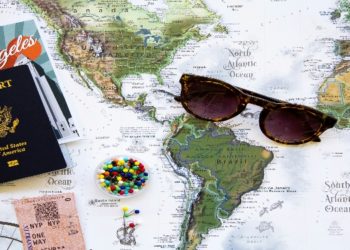Why Europe is a remarkable place for a road trip
There are so many reasons why a road trip is one of the best ways to travel around Europe. For one, it’s a great way to see multiple countries in a short amount of time while being incredibly diverse, meaning there’s something to suit everyone’s taste. From the stunning beaches of Spain to the magical fairy tale castles in Germany, you’re spoiled for choice and can also go at your own pace while making stops wherever you want.
Additionally, road trips are usually more affordable than other types of travel, making them a great option for budget-minded travellers. And let’s not forget about the food! European cuisine is some of the best in the world, and you’ll have plenty of opportunity to sample it when you’re on your road trip. Best of all, it doesn’t have to be expensive. With careful planning, you can enjoy an unforgettable European road trip without breaking the bank.
A few advices when hiring your campervan

The first step to an affordable European road trip is hiring the optimal campervan. This will provide optimal freedom and flexibility when travelling, as well as significantly reducing accommodation costs. In addition, a campervan allows you to truly experience the beauty of Europe at your own pace, without being restricted as much by timetables or hotel bookings. Here are a few key things to consider when hiring a campervan:
– Compare different companies and make sure you get the best value for money by looking into what services are included in the price of hire. This could include such things as insurance, breakdown cover, mileage limits and any extra fees such as cleaning fees or fuel costs. Once you have all of this information, you can then start to compare prices and find the rental package that best fits your needs.
– Another thing to consider is what type of campervan you’ll need. Do you need something large enough to fit two people or more? Or perhaps something more compact will work better for a solo traveller? Think about how much space you need as well as any special features such as air conditioning or an onboard kitchenette that may be necessary for your journey. It’s also important to get insurance for your campervan so you can protect yourself in case of any accidents or issues. This way, if anything goes wrong with the van, you won’t have to pay for it yourself.
– Finally, don’t forget to check out reviews from other customers who have hired from the same company – this will give you an idea of their customer service and reliability. Make sure the campervan is in good condition and that there are no hidden extras or additional costs that weren’t mentioned when booking. It’s important to inspect the campervan before you rent it, so you can make sure there aren’t any damages or problems. If everything looks good and ticks all of your boxes, then go ahead and book – happy travels!
How to plan an affordable European road trip
Europe is the perfect place for a road trip. With its multitude of countries, picturesque scenery, and accessible highways, there’s no shortage of options when it comes to planning your route. But with so many possibilities, it can be daunting to know where to start – or even more importantly, how to do it without breaking the bank. As such, here are a few tips on how to plan an affordable European road trip:

1. Choose your destination and route – One of the most important elements of planning an affordable European road trip is selecting a destination and route that’s within your budget. You can choose anywhere in Europe, but some regions are more popular than others. France, Italy, and Spain are all great options to start with.
If you’re looking for an affordable option, contemplate countries like Poland, Hungary or the Czech Republic. These countries offer great value for money, without sacrificing on culture or scenery. You can also try and consider places off the beaten path that offer great value for money and research routes with fewer tolls and lower fuel costs. Travel blogs & destination guides can be of great help if you’re not familiar with your destination.
2. Keep an eye on accommodation costs – Once you’ve picked a destination, start looking for accommodations in the area. Accommodation costs can quickly add up on a road trip, so consider budget-friendly options like camping, hostels or Airbnb rentals.
Booking ahead of time will save you money, allow you to get the best deals, and give you the peace of mind that you won’t be left stranded when you arrive at your destination. Once you’ve got your travel arrangements and lodging sorted out, it’s time to start planning your itinerary!
3. Plan your itinerary in advance – There are tons of things to do and see in Europe, so be sure to make a list of all the places you want to go and activities you aim to do throughout your journey. This will help keep your plans organized and ensure that you don’t miss any must-see sights. Take advantage of local discounts & free attractions.
When planning your itinerary, be sure to look out for local tourist attractions with discounted entry fees or special offers available throughout the year – this could help save you money on some of the more expensive activities on your trip. Many European cities also offer a wealth of free attractions, so do some research before you go and make sure you make the most of them! From parks and museums to walking tours and street art, there’s plenty to see and do without spending any money at all.
When it comes to eating and drinking while on vacation, it’s always good to be mindful of your budget. Try to stick to local restaurants and avoid tourist traps when possible. Also, be sure to take advantage of any discounts or deals that hotels or restaurants may offer during your stay. If you’re travelling by car, research petrol prices before setting off and check if there are any discounts available for toll roads or train fares that might save you money over time.
4. Travel during the shoulder season – The shoulder season is the period between the high season and low season, and it’s often much cheaper to travel during this time. For example, you can usually find cheaper accommodation and flights if you travel to Europe in the spring or fall.
5. Avoid peak travel times – Try to avoid travelling during peak times. This includes holidays, summer and winter breaks, and any other time when demand is high. Fly mid-week. It’s often cheaper to fly on weekdays rather than weekends, so if you can be flexible with your travel dates, try to book your flights for Tuesday, Wednesday or Thursday. If you have any loyalty cards or rewards points (such as miles), be sure to use them when booking your flights or accommodation. This could save you a lot of money in the long run.
6. Pack light – remember, you’ll be doing a lot of driving so you don’t want to be lugging around a heavy suitcase. Stick to the essentials and pack items that are versatile and can be mixed and matched. The less luggage you have, the cheaper it will be to travel. Not only will you save money on baggage fees, but you’ll also save time by not having to wait for your luggage at the airport.
7. Eat like a local – One of the best ways to save money on food is to eat like the locals do. Visit markets and street stalls instead of restaurants, and you’ll be able to sample the local cuisine at a fraction of the price, so seek them out when possible! When it comes to food, one of the best ways to save money is by eating like a local. Street stalls and markets offer delicious local cuisine at a fraction of the price of restaurants, so seek them out when possible!
The best routes for a European road trip

If you’re looking for an affordable European road trip itinerary, here are some of the best routes available for a European road trip on a budget:
1. The Balkan Peninsula – This region is home to some of the most beautiful scenery in Europe, and it’s also very affordable. Start in Slovenia and explore countries like Croatia, Bosnia & Herzegovina, Montenegro, and Albania.
2. The Iberian Peninsula – Spain and Portugal are both great countries to visit on a budget. Start in Barcelona and head down to Andalusia, or start in Lisbon and explore Portugal’s stunning coastal towns.
3. Eastern Europe – If you’re looking for even more affordable travel, Eastern Europe is the place to go. Countries like Poland, Hungary, Czech Republic, and Slovakia are all great options for a road trip.
4. Scandinavia – This region is known for being expensive, but if you plan your route carefully you can still visit on a budget. Start in Norway and explore the country’s stunning fjords, then head over to Denmark, Sweden, or Finland.
5. The United Kingdom – Last but not least, don’t forget about the UK! England, Scotland, Wales, and Northern Ireland are all great places to explore by car. So, there you have it – five of the best routes for a European road trip on a budget.
What to pack for a European road trip
When you’re planning a European road trip, one of the most important factors to consider is what to pack. Travelling light and only taking the essentials means you can enjoy more freedom on your journey. Here are our top tips on what to bring with you:
1. Start with the basics – a good map and a reliable car are key. Make sure your vehicle is in good condition and that you have all the necessary paperwork (including insurance) in order. You may think that having a map in this day and age isn’t necessary, but it can be invaluable when exploring remote areas or countries where internet access is limited. It also helps you to plan your route more efficiently, so you get the most out of your road trip.
2. An emergency kit – This should include first aid supplies, a torch, spare batteries, and other essential items that could prove useful in an emergency. It’s always better to be safe than sorry!
3. Comfortable clothes – Layering up is key for a European road trip; temperatures vary greatly throughout the continent, from hot Mediterranean summers to cold, snowy winters, so make sure you’re prepared for all weathers. Invest in some quality walking boots too; they’ll be invaluable when visiting scenic destinations off the beaten track.
4. Entertainment and sustenance – There’s nothing worse than being bored on long drives, so make sure to pack items such as books or games that will keep everyone entertained during those long hours in the car! Snacks are always a good idea when travelling, especially if you’re going to be out all day exploring the sights and scenery of Europe. Pack some trail mix, granola bars, or other snacks that will keep you energized throughout the day.
5. A budget – Last but not least, don’t forget to plan your budget before you set off! Knowing how much money you have available will help you plan your trip accordingly and ensure it stays within your price range. While many places in Europe now accept credit cards, it’s still a good idea to have some cash on hand. This is especially true if you intend to do any shopping or dining out. Remember: planning ahead is key when it comes to an affordable European road trip!
With these tips in mind, you can start packing for your dream adventure today!
Conclusion
So, there you have it, our ultimate guide to an affordable European road trip. We hope we’ve convinced you that it’s possible to have an amazing time without spending a fortune, and that with a little creativity and planning, you can make your dream trip a reality. Happy travels!
David Prior
David Prior is the editor of Today News, responsible for the overall editorial strategy. He is an NCTJ-qualified journalist with over 20 years’ experience, and is also editor of the award-winning hyperlocal news title Altrincham Today. His LinkedIn profile is here.













































































